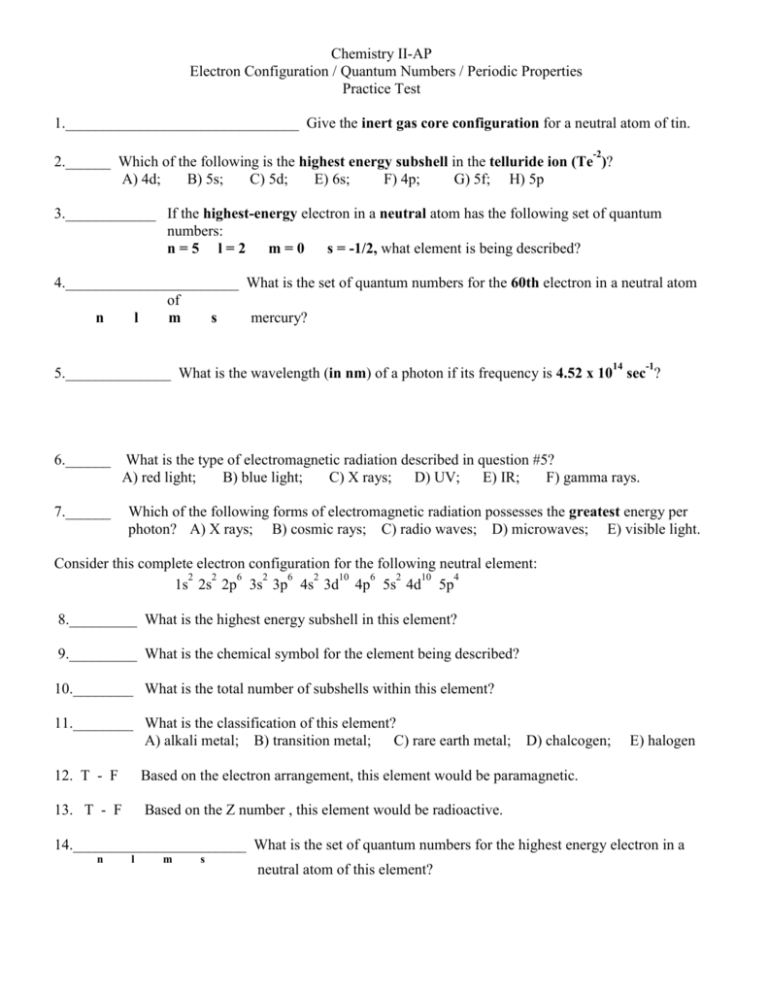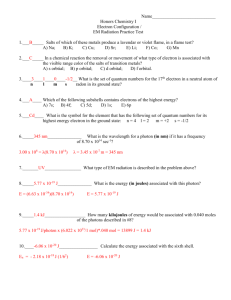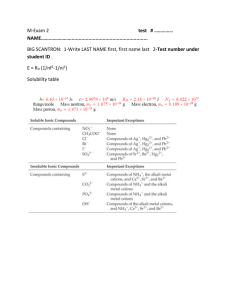El. Config. Per. Props. Practice Test
advertisement

Chemistry II-AP Electron Configuration / Quantum Numbers / Periodic Properties Practice Test 1._______________________________ Give the inert gas core configuration for a neutral atom of tin. -2 2.______ Which of the following is the highest energy subshell in the telluride ion (Te )? A) 4d; B) 5s; C) 5d; E) 6s; F) 4p; G) 5f; H) 5p 3.____________ If the highest-energy electron in a neutral atom has the following set of quantum numbers: n=5 l=2 m=0 s = -1/2, what element is being described? 4._______________________ What is the set of quantum numbers for the 60th electron in a neutral atom of n l m s mercury? 14 -1 5.______________ What is the wavelength (in nm) of a photon if its frequency is 4.52 x 10 sec ? 6.______ 7.______ What is the type of electromagnetic radiation described in question #5? A) red light; B) blue light; C) X rays; D) UV; E) IR; F) gamma rays. Which of the following forms of electromagnetic radiation possesses the greatest energy per photon? A) X rays; B) cosmic rays; C) radio waves; D) microwaves; E) visible light. Consider this complete electron configuration for the following neutral element: 2 2 6 2 6 2 10 6 2 10 4 1s 2s 2p 3s 3p 4s 3d 4p 5s 4d 5p 8._________ What is the highest energy subshell in this element? 9._________ What is the chemical symbol for the element being described? 10.________ What is the total number of subshells within this element? 11.________ What is the classification of this element? A) alkali metal; B) transition metal; C) rare earth metal; D) chalcogen; 12. T - F Based on the electron arrangement, this element would be paramagnetic. 13. T - F Based on the Z number , this element would be radioactive. E) halogen 14._______________________ What is the set of quantum numbers for the highest energy electron in a n l m s neutral atom of this element? -2-3 15._______________________________ Give the inert gas core configuration for the arsenide ion (As ). 16.__________________ How much energy (in joules) is emitted when a single photon with a wavelength of 11,050 Angstroms is released? 17.___________________ How much energy is associated with a single electron species if the electron is in the fourth shell? 18.___________________ If that same electron in #17 drops back to the third shell, what wavelength of EM radiation is emitted when this drop occurs? 19._______ Which of the following sets of quantum numbers is/are acceptable for an electron of a neutral atom of radium (Z# = 88)? Note: This does not necessarily mean the highestenergy electron. n l m s n l m s 1) 6 0 1 -1/2 4) 2 2 -1 +1/2 2) 4 2 -2 +1/2 5) 7 0 0 -1/2 3) 5 3 0 +1/2 6) 6 2 -2 -1/2 A) only 2; B) only 3; C) only 6; D) both 3 &4; E) both 1 & 5; F) both 2 & 5. 20. Give the core electron configuration for a neutral copper atom. Explain the reason(s) for this abnormality. -321.______ In a chemical reaction the removal or movement of what type of electron is associated with the visible range color of the salts of transition metals? A) s orbital; B) p orbital; C) d orbital; D) f orbital. 22.______ What element is it whose neutral, isolated atom has two valence electrons in the 4s subshell, two filled orbitals and one half-filled orbital in the 4p subshell (in addition to its core electrons)? 23.______ How many electrons are needed to fill the "M" shell? 24.______ Dubnium used to be named “hahnium”. How many shells are either filled or partially filled in a neutral atom of dubnium (Z # = 105)? 25._______ Which of the following neutral atoms has the largest atomic volume? A) Sc; B) K; C) Si; D) Ga; E) Cs; F) Cl 26._______ Which of the following species would you expect to have the largest radius? -3 -2 +2 A) As ; B) Ne; C) S ; D) Mg ; E) F . 27.________ Which of the following elements has the highest first ionization energies? A) Al; B) Mg; C) Hg; D) Cl; E) I 28._______ Which of the following elements has the lowest boiling point? A) Li; B) B; C) C D) Sc; E) He; F) Hg 29._______ Which of the following has the largest ionic size? + +2 +3 A) Na ; B) Mg ; C) Al ; D) F ; -2 E) Se 30._______ Which of the following has the greatest (highest) electronegativity value? A) Au; B) Bi; C) Se; D) Cl; E) Ar. 31 - 32. Take one of the periodic properties that we have studied and explain how the phenomenon of the "lanthanide contraction" produces irregularities within this property. -433._______ Which of the following elements would be expected to show an electron affinity with a negative value? A) As; B) Ba; C) Cd; D) Cl; E) N; F) both B and C. 34._______ Which of the following would be expected to have the greatest density? A) Os; B) F; C) Zn; D) Pb; E) At; F) Pd 35._______ Which of the following shows the most metallic character? A) As; B) Cs; C) B; D) Te; E) Zn. 36._______ Which of the following salts has color (is not a white salt)? A) ZnCl2; B) Fe(NO3)3; C) Al2O3; D) NaCl; E) K2SO4 37._______ What is the symbol for the metal that is the third best conductor of electricity? 38._______ Which of the following compounds, when dissolved in water, would exhibit amphoterism? A) Mn2O7; B) MnO2; C) FeO; D) CrO; E) CrO3 Essays: Be prepared to write clear, yet concise, essays on each of the following topics. 1. 2. 3. 4. 5. Compare and contrast the work of Balmer and Lyman. State the Heisenberg Uncertainty Principle and explain its importance. Explain the significance of de Broglie's "matter waves". Explain how Einstein's photoelectric effect was related to the study of electron movement. State the Pauli Exclusion Principle and explain its importance in terms of the energy of electrons.








